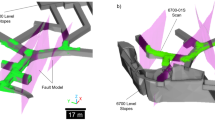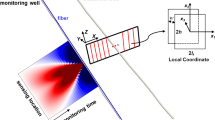Abstract
Monitoring and predicting crack propagation in rock using acoustic emission (AE) technology is integral to a variety of sub-disciplines in the geosciences. The utility of existing AE data, however, is severely limited by prevailing visualization techniques, which suffer from problems of occlusion. Here, we introduce a novel approach to visualize 3D data through time (4D data) using unfiltered individual (AE) event data collected from a granite boulder for a period over 3 years. We implement a 3D extension of Ripley’s K function to evaluate the magnitude of clustering, and use the scale at which clustering is strongest to parameterize three-dimensional kernel density estimation (3DKDE) of AE events. We develop a parallel approach that features a load balancing technique to decrease the computational effort for 3DKDE and hence, reduce execution time. The results from the 3DKDE allow for comprehensible visualization of high AE density areas—best reflecting the actual location of subcritical cracking—and their changes through time, which is a substantial improvement over most existing methods. Our framework is scalable and portable to a variety of other disciplines such as epidemiology, ecology, and any point data by extension. Assumptions and limitations are identified as well as possible future research directions.







Similar content being viewed by others
References
Aldred J, Eppes MC, Aquino K, Deal R, Garbini J, Swami S, Tuttle A, Xanthos G (2015) The influence of solar-induced thermal stresses on the mechanical weathering of rocks in humid mid-latitudes. Earth Surface Process Landf 41(5): 603–614
Anton-Sanchez L, Bielza C, Merchán-Pérez A, Rodríguez J-R, DeFelipe J, Larrañaga P (2014) Three-dimensional distribution of cortical synapses: a replicated point pattern-based analysis. Front Neuroanatomy 8:85
Bach B, Dragicevic P, Archambault D, Hurter C, Carpendale S (2016) A Descriptive Framework for Temporal Data Visualizations Based on Generalized Space-Time Cubes. In: Paper read at Computer Graphics Forum
Baddeley AJ, Møller J, Waagepetersen R (2000) Non-and semi-parametric estimation of interaction in inhomogeneous point patterns. Stat Neerl 54(3):329–350
Bader M (2012) Space-filling curves: an introduction with applications in scientific computing: Springer, Berlin, Heidelberg
Bailey TC, Gatrell AC (1995) Interactive spatial data analysis. Addison Wesley Longman, Essex, UK
Bolibok L (2008) Limitations of Ripley K function use in the analysis of spatial patterns of tree stands with heterogeneous structure. Acta Scientiarum Polonorum Silvarum Colendarum Ratio et Industria Lignaria 7(1):5–18
Delmelle E (2009) Point pattern analysis. Int Encycl Human Geogr 8: 204–211
Delmelle E, Dony C, Casas I, Jia M, Tang W (2014) Visualizing the impact of space-time uncertainties on dengue fever patterns. Int J Geogr Inf Sci 28(5):1107–1127
Dixon PM (2002) Ripley’s K function. Encyclopedia of environmetrics
Duca S, Occhiena C, Mattone M, Sambuelli L, Scavia C (2014) Feasibility of ice segregation location by acoustic emission detection: a laboratory test in gneiss. Permafrost Periglac Process 25(3):208–219
Ech-Choudany Y, Assarar M, Scida D, Morain-Nicolier F, Bellach B (2017) Unsupervised clustering for building a learning database of acoustic emission signals to identify damage mechanisms in unidirectional laminates. Appl Acoust 123:123–132
Eppes M-C, Keanini R (2017) Mechanical weathering and rock erosion by climate-dependent subcritical cracking. Rev Geophys 55(2):470–508
Eppes MC, McFadden LD, Wegmann KW, Scuderi LA (2010) Cracks in desert pavement rocks: Further insights into mechanical weathering by directional insolation. Geomorphology 123(1):97–108
Eppes MC, Magi B, Hallet B, Delmelle E, Mackenzie-Helnwein P, Warren K, Swami S (2016) Deciphering the role of solar-induced thermal stresses in rock weathering. Geol Soc Am Bull 128(9–10):1315–1338
Fayyad U, Piatetsky-Shapiro G, Smyth P (1996) From data mining to knowledge discovery in databases. AI Mag 17(3):37
Forkert ND, Fiehler J, Illies T, Möller DP, Handels H, Säring D (2012) 4D blood flow visualization fusing 3D and 4D MRA image sequences. J Magn Reson Imaging 36(2):443–453
Girard L, Gruber S, Weber S, Beutel J (2013) Environmental controls of frost cracking revealed through in situ acoustic emission measurements in steep bedrock. Geophys Res Lett 40(9):1748–1753
Godin N, Huguet S, Gaertner R, Salmon L (2004) Clustering of acoustic emission signals collected during tensile tests on unidirectional glass/polyester composite using supervised and unsupervised classifiers. Ndt E Int 37(4):253–264
Goebel T, Becker T, Schorlemmer D, Stanchits S, Sammis C, Rybacki E, Dresen G (2012) Identifying fault heterogeneity through mapping spatial anomalies in acoustic emission statistics. J Geophys Res Solid Earth 117(B3):1–18
Grosse CU, Ohtsu M. 2008. Acoustic emission testing: Springer, Berlin, Heidelberg
Grubesic TH, Wei R, Murray AT (2014) Spatial clustering overview and comparison: accuracy, sensitivity, and computational expense. Ann Assoc Am Geogr 104(6):1134–1156
Handels H, Werner R, Schmidt R, Frenzel T, Lu W, Low D, Ehrhardt J (2007) 4D medical image computing and visualization of lung tumor mobility in spatio-temporal CT image data. Int J Med Inform 76:S433-S439
Hauer M (2013) A 3D spatio-temporal geovisualization of subcounty estimates of historic housing density in Metro Atlanta, 1940–2009. Spat Demogr 1(2):146–161
Heap M, Baud P, Meredith P, Bell A, Main I (2009) Time-dependent brittle creep in Darley Dale sandstone. J Geophys Res Solid Earth 114:(B7)
Heap M, Farquharson J, Baud P, Lavallée Y, Reuschlé T (2015) Fracture and compaction of andesite in a volcanic edifice. Bull Volcanol 77(6):1–19
Hesser J, Kaiser D, Schmitz H, Spies T (2015) Measurements of acoustic emission and deformation in a repository of nuclear waste in salt rock. In: Lollino G et al (eds) Engineering geology for society and territory-volume 6. Springer, pp 551–554
Hohl A, Delmelle E, Tang W (2015) Spatiotemporal domain decomposition for massive parallel computationa of space-time kernel density. ISPRS Ann Photogramm Remote Sens Spat Inform Sci 2: 7–11
Hohl A, Delmelle E, Tang W, Casas I (2016a) Accelerating the discovery of space-time patterns of infectious diseases using parallel computing. Spatial Spatio Temp Epidemiol 19:10–20
Hohl A, Casas I, Delmelle E, Tang W. 2016b. Hybrid Indexing for parallel analysis of spatiotemporal point patterns. In: International Conference on GIScience Short Paper Proceedings (Vol. 1, No. 1)
Hohl A, Zheng M, Tang W, Delmelle E, Casas II (2017) Spatiotemporal point pattern analysis using Ripley’s K function. In: Karimi HA, Karimi B (eds) Geospatial data science: techniques and applications. CRC Press, Boca Raton, FL
Hütteroth W-D, El Jundi B, Jundi SE, Schachtner J (2010) 3D-reconstructions and virtual 4D-visualization to study metamorphic brain development in the sphinx moth Manduca sexta: Bibliothek der Universität Konstanz
Iverson N, Kao CS, Labuz JF (2007) Clustering analysis of AE in rock. J Acoust Emission 25:364–372
Lei X, Kusunose K, Rao M, Nishizawa O, Satoh T (2000) Quasi-static fault growth and cracking in homogeneous brittle rock under triaxial compression using acoustic emission monitoring. J Geophys Res Solid Earth (1978–2012) 105(B3):6127–6139
Levoy M (1988) Display of surfaces from volume data. IEEE Comput Graph Appl 8(3):29–37
Li Y, Liu J, Zhao X, Yang Y (2010) Experimental studies of the change of spatial correlation length of acoustic emission events during rock fracture process. Int J Rock Mech Min Sci 47(8):1254–1262
Li J, Jiang Y, Yang C, Huang Q, Rice M (2013) Visualizing 3D/4D environmental data using many-core graphics processing units (GPUs) and multi-core central processing units (CPUs). Comput Geosci 59:78–89
Lockner D (1993) The role of acoustic emission in the study of rock fracture. In: Paper read at International Journal of Rock Mechanics and Mining Sciences & Geomechanics Abstracts
Moriya H, Manthei G, Mochizuki S, Asanuma H, Hitsuma H, Jones R, Eisenblätter J (2002) Collapsing method for delineation of structures inside AE cloud associated with compression test of salt rock specimen. In: Paper read at 16th International Acoustic Emission Symposium
Nguyen HT (2015) The approach of space-time cube to visualizing movement data. Int J Model Optim 5(3):207
Olsson W, Holcomb D (2000) Compaction localization in porous rock. Geophys Res Lett 27(21):3537–3540
Pfister GF (2001) An introduction to the infiniband architecture. High Perform Mass Storage Parallel I/O 42:617–632
Ramasso E, Placet V, Boubakar ML (2015) Unsupervised consensus clustering of acoustic emission time-series for robust damage sequence estimation in composites. IEEE Trans Instrum Meas 64(12):3297–3307
Resch B, Wohlfahrt R, Wosniok C (2014) Web-based 4D visualization of marine geo-data using WebGL. Cartogr Geogr Inform Sci 41(3):235–247
Rodríguez P, Arab PB, Celestino TB (2016) Characterization of rock cracking patterns in diametral compression tests by acoustic emission and petrographic analysis. Int J Rock Mech Min Sci 83:73–85
Stephansson O, Stanchits S, Backers T, Dresen G, Shen B. (2005) Fracturing, acoustic emission and numerical simulation of granite under mode II loading. In: Paper read at ICF11, Italy 2005
Tang W, Feng W, Jia M (2015) Massively parallel spatial point pattern analysis: Ripley’s K function accelerated using graphics processing units. Int J Geogr Inf Sci 29(3):412–439
Warren K, Eppes M-C, Swami S, Garbini J, Putkonen J (2013) Automated field detection of rock fracturing, microclimate, and diurnal rock temperature and strain fields. Geosci Instr Methods Data Syst 2(2):275–288
Wilkinson B, Allen M (2004) Parallel programming: techniques and applications using networked workstations and parallel computers, 2 edn. Pearson Prentice Hall, Upper Saddle River
Yamada I, Rogerson PA (2003) An empirical comparison of edge effect correction methods applied to K-function analysis. Geograph Anal 35(2):97–109
Yanagidani T, Ehara S, Nishizawa O, Kusunose K, Terada M (1985) Localization of dilatancy in Ohshima granite under constant uniaxial stress. J Geophys Res Solid Earth 90(B8):6840–6858
Zang A, Christian F, Wagner, Dresen G (1996) Acoustic emission, microstructure, and damage model of dry and wet sandstone stressed to failure. J Geophys Res Solid Earth 101(B8):17507–17521
Zang A, Christian Wagner F, Stanchits S, Dresen G, Andresen R, Haidekker MA (1998) Source analysis of acoustic emissions in Aue granite cores under symmetric and asymmetric compressive loads. Geophys J Int 135(3):1113–1130
Zhao X, Cai M, Wang J, Ma L (2013) Damage stress and acoustic emission characteristics of the Beishan granite. Int J Rock Mech Min Sci 64:258–269
Author information
Authors and Affiliations
Corresponding author
Additional information
Publisher's Note
Springer Nature remains neutral with regard to jurisdictional claims in published maps and institutional affiliations.
Rights and permissions
About this article
Cite this article
Hohl, A., D. Griffith, A., Eppes, M.C. et al. Computationally Enabled 4D Visualizations Facilitate the Detection of Rock Fracture Patterns from Acoustic Emissions. Rock Mech Rock Eng 51, 2733–2746 (2018). https://doi.org/10.1007/s00603-018-1488-z
Received:
Accepted:
Published:
Issue Date:
DOI: https://doi.org/10.1007/s00603-018-1488-z




